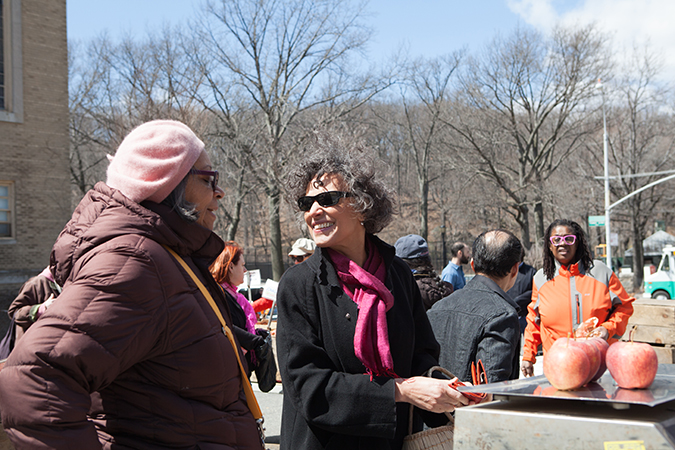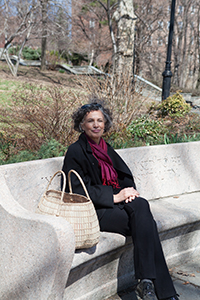My New York Story

By Mary Travis Bassett, MD, MPH
I have lived in Inwood, the northernmost neighborhood in Manhattan, for the past 15 years. And, unlike many New Yorkers, I live in the neighborhood in which I actually grew up. I’m proud to call Inwood home. “Upstate Manhattan,” as some call this area, has great natural charm and green spaces – Inwood Park has an original growth forest! I’m especially fond of the place where I got my first library card and my love for reading blossomed – the Inwood Library. The Washington Heights/Inwood neighborhood has seen waves of immigrant arrivals – Irish, Jewish, and more recently, Dominicans. Today, my drycleaner is from Ghana, my tailor from Peru, my corner store is staffed mainly by people from Yemen, my florist is from Mexico and my current favorite restaurant is owned by someone from the Dominican Republic. This is New York – a city of immigrants.
As an almost native New Yorker (I came here from Ohio when I was 3), I take daily pleasure in all that our city has to offer. Each of the five boroughs is filled with diverse, vibrant neighborhoods. I love being able to take the subway just a few stops and find an entirely different neighborhood to experience. Unfortunately, in the most diverse city in the world, a short subway ride can also reveal unnatural differences in health. A few subway stops away, a fellow New Yorker may live as many as 11 years less than someone living in a more affluent NYC neighborhood.
What I want and what this city needs is to keep its diversity while ending gaps in life chances. Making sure that every neighborhood is a healthy neighborhood will make our city more hopeful and vibrant. For generations, people living in historically segregated and deprived neighborhoods, often Blacks and Latinos, have shouldered the heaviest burden of disease in our city. Though the leading causes of death are the same across all racial and ethnic groups, Black and Latino New Yorkers are more likely by far to die before age 65. There’s no biological difference between races such that we should expect different health outcomes. It’s unconscionable that someone’s New York City experience may differ so greatly depending on the neighborhood they call home.
Learning more about my neighbors is what led me to seek a career in medicine. In the summer between high school and college, I took a job as a census taker in Harlem. Equipped with my census satchel, I had the privilege of going into people’s homes and learning more about their lives. The number of people I saw who had obvious health problems surprised me. I decided to become a doctor, as far as I know, the first in my family.
After medical school, I completed my training at Harlem Hospital. My residency began at the beginning of the 1980s, when the crack and HIV/AIDS epidemics tore through the community. I was treating patients, but saw them return days or weeks later. I realized that no matter what we did inside the walls of the hospital, it was the environment outside of the hospital that prevented my patients from staying healthy. Within the hospital walls, I couldn’t improve my patients’ substandard housing, unemployment or any of the other factors that affect a person’s ability to lead a healthy life.
Later, I would live in in Zimbabwe and other parts of Africa, where I learned how other countries approach community health. Working there brought its own challenges. I was there at the beginning of the AIDS crisis, and watched friends, colleagues, students and patients die, despite our best efforts.
After returning from Africa, I took what I learned to my first Health Department job as Deputy Commissioner for Health Promotion and Disease Prevention. Shortly after arriving in 2002, I established District Public Health Offices in East and Central Harlem, the South Bronx and North and Central Brooklyn to lead targeted programs in these communities, which experience an excess burden of disease. The Health Department staff members who work in these offices have become part of the fabric of the communities we serve, and we’re going to continue to build on that.

We will soon open Neighborhood Health Action Centers, which will better link residents of neighborhoods with high rates of chronic disease and premature death to local primary care and community services. The Action Centers will provide space for community-based organizations and Health Department staff to work together to advance neighborhood health.
As the City’s doctor, I don’t take my responsibilities lightly. The public health approach considers the many facets of what makes for a healthy life – where we live, work, play and pray. Under Mayor Bill de Blasio, we’re doing our best to leave no rock unturned. We’re implementing policies and programs to lift up every resident, not just those who have the means. We’re making sure our little ones get a jump start in life through home visiting and early intervention programs and free, high-quality pre-kindergarten.
In the area of nutition one of our initiatives is implementing a new sodium warning label that empowers people to make informed decisions about the food they consume and better watch their salt intake. We’re improving our fragmented mental health system, and so much more.
We’re doing this because we know that for people to live healthier, we have to restore choice. People need good housing, a more livable wage, good education, and access to services to take control of their health. All of these things help build a healthy neighborhood.
I look forward to living in a city where neither a New Yorker’s ZIP code nor skin color will have a bearing on their health or how long they will live. We have a great diversity of cultures, foods, lifestyles, spaces and experiences. A difference in health outcomes is one we can do without.



